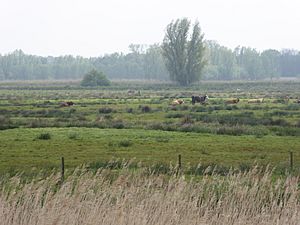Barnby Broad and Marshes facts for kids
| Site of Special Scientific Interest | |

Castle Marshes
|
|
| Area of Search | Suffolk |
|---|---|
| Coordinates | 52°28′08″N 1°38′49″E / 52.469°N 1.647°E |
| Interest | Biological |
| Area | 189.62 hectares (1.9 km2; 0.73 sq mi) |
| Notification | 1990 |
Barnby Broad and Marshes is a very special nature area in Suffolk, England. It's called a Site of Special Scientific Interest (SSSI) because of its amazing wildlife.
This area covers about 189.6 hectares (469 acres) of land. That's like 470 football fields! You can find it between the towns of Beccles and Lowestoft. A railway line runs along its south side, and the River Waveney is to its north.
This place is super important for nature! It's a Special Area of Conservation, a Special Protection Area for birds, and a Ramsar site (meaning it's a globally important wetland). Two Suffolk Wildlife Trust nature reserves, Castle Marshes and North Cove, are part of this special place.
Barnby Broad and Marshes has different types of habitats. These include grassy marshes, wet woodlands (called carr woodland), fens, and open water. Much of the area floods when it rains a lot. This creates a perfect home for many different kinds of birds.
Contents
What is Barnby Broad?
Barnby Broad is an area of open water, about 2.5 hectares (6.2 acres) in size. It was formed a long time ago when people cut out peat (a type of soil) from the ground. This is how many of the "Broads" in this region were made.
The Broad is privately owned. In 2007, it was cleaned to make it a better home for wildlife. Also, dirty water from farms was stopped from flowing into it.
Animals and Plants at Barnby Broad
You can find many interesting plants and animals here. Look for the beautiful white water-lily and common reed. There are also rarer plants like tussock-sedge and marsh arrowgrass. You might even spot the southern marsh-orchid!
The Broad is surrounded by a mature Alder woodland. Here, you'll see trees like Ash and Oak.
Exploring Castle Marshes
Castle Marshes is the grassy marsh part of this special area. It covers the flood plain of the River Waveney. This area is managed by letting cattle graze, which helps the plants grow well.
Amazing Wildlife at Castle Marshes
Many rare insects live here, like the Norfolk hawker dragonfly. A special project even brought back the protected fen raft spider to this site!
In winter, the marshes flood, creating a perfect home for many birds. You can see birds like teal, shoveller, and gadwall. In spring, lapwing and common redshank come here to breed. Birds of prey, like the marsh harrier and hobby, also hunt here.
Most of Castle Marshes is a nature reserve managed by the Suffolk Wildlife Trust. This part is about 71 hectares (180 acres) in size. You can walk along public footpaths by the river to see some of the reserve.
North Cove Nature Reserve
A smaller part of the area, about 38.8 hectares (96 acres), is also managed as a nature reserve by the Suffolk Wildlife Trust. This reserve has a mix of woodlands, pools, and marshland. It used to be a place for game animals.
Special Species at North Cove
Here, you can find the nationally rare marsh fern. Birds like the woodcock also live here. And just like Castle Marshes, the Norfolk hawker dragonfly can be seen flying around this site.

